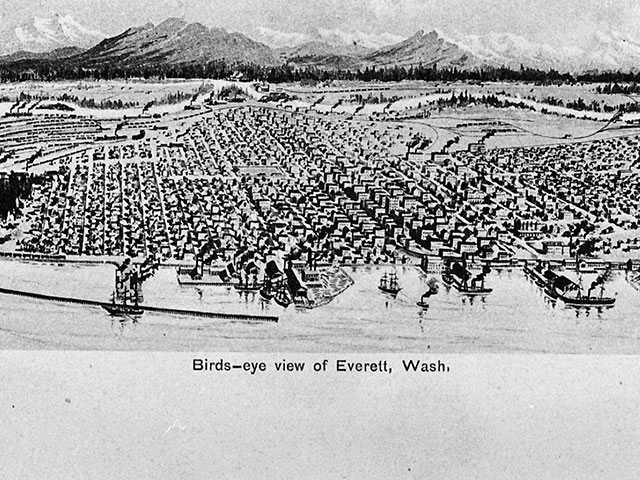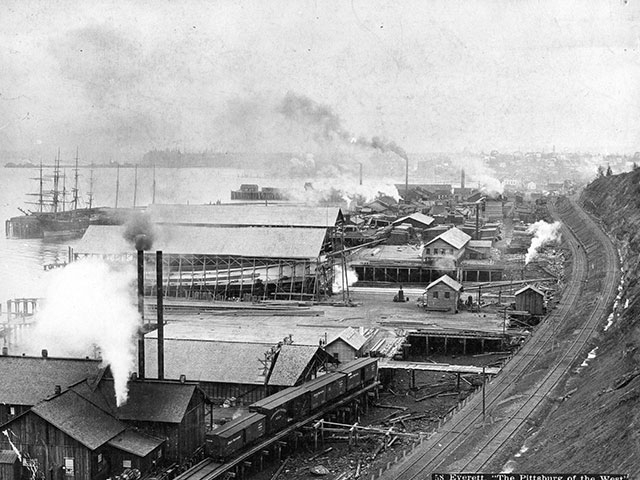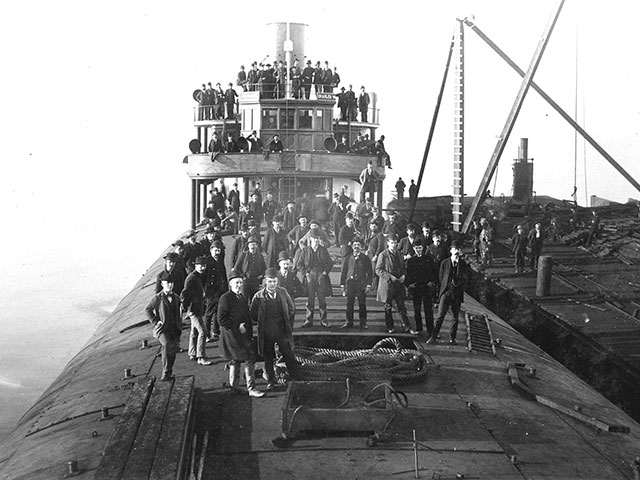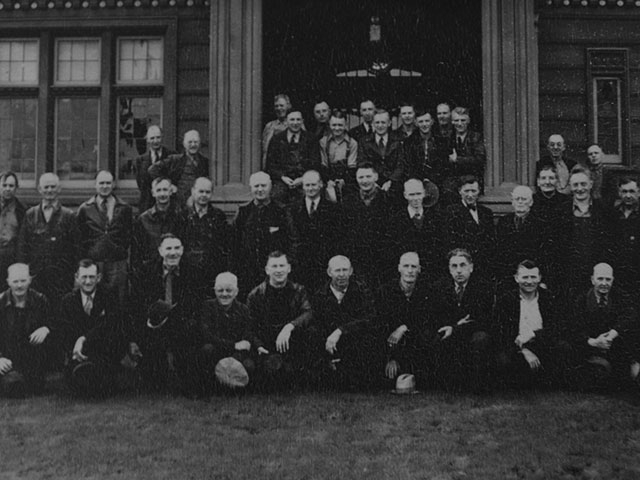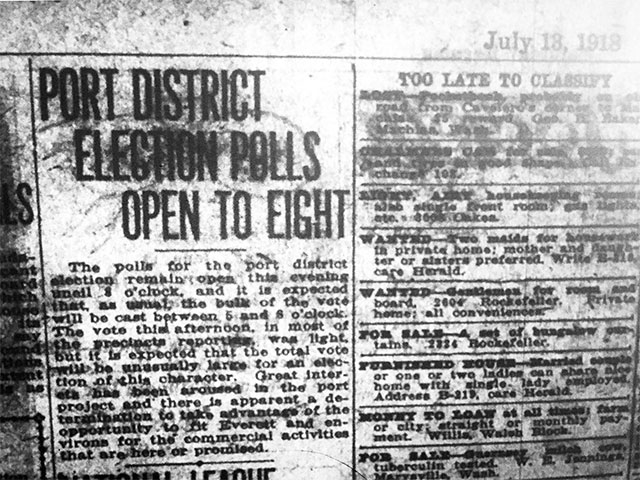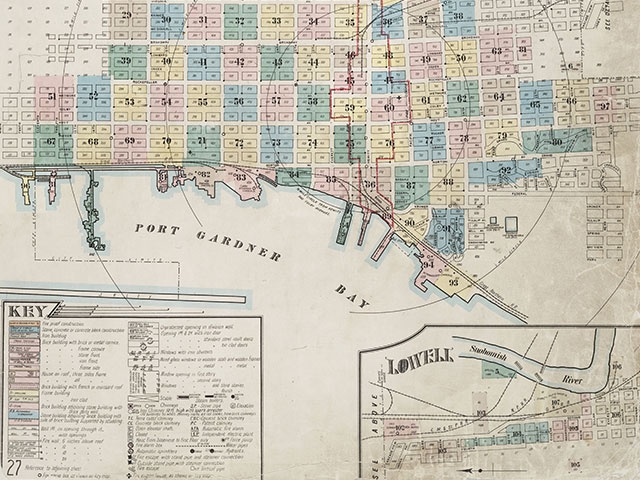1800s - 1919
Timeline
1855
On January 22, several Puget Sound-area Native American tribes sign the Treaty of Point Elliott at Muckl-te-oh, or Point Elliott (today’s Mukilteo), ceding much of their lands to the U.S. government, including a large village — Hibulb — at the northern tip of the Port Gardner Peninsula. The agreement guarantees hunting and fishing rights to local Native Americans and establishes several Native American reservations, including one for local indigenous peoples, which becomes known as the Tulalip Indian Reservation. The treaty spurs additional European-American settlement in the area.
1890
The Everett Land Company is formed by HenryHewitt Jr., Charles L. Colby and others, with financial backing from John D. Rockefeller. The group plans Everett as an industrial city. The city is named “Everett,” after Colby’s son.
1891
The Seattle & Montana Railroad from Seattle toVancouver, B.C., is completed, linking Everett to major cities north and south. The line runs along Everett’s waterfront.
1891
In December, the Charles W. Wetmore steel-hulled “whaleback” freighter arrives at Port Gardner Bay, carrying goods for the area’s fledgling factories, as well as iron with which to establish a bargeworks
1891-92
One of Everett’s first businesses, Puget Sound Wire Nail and Steel Company, is established along Port Gardner Bay. The city’s first dock is built bayside for the nailworks, around what would be the foot of Pacific Avenue (today the site of Pier 1.) Around this time the Rucker Dock (later City Dock, then Pier 2) is built at the foot of Hewitt Avenue; by the early 1900s that dock would become the major connecting point for both passenger and commercial travel.
1892
The Everett Land Company builds the 14th Street Dock and opens the first business on the west end of the dock, a sawmill. A few weeks later, the Neff and Mish Shingle Mill is built on the north side of the dock.
1893
The Great Northern Railway line from points in the Eastern U.S. is completed to Everett; boxcars of Neff and Mish shingles are the first rail cargo to leave Everett for Eastern U.S. markets.
1893
The Everett Land Company submits a plan to the federal government to build a freshwater harbor at the mouth of the Snohomish River; work on a “training dike” made of loose stone begins in 1895 but plans are abandoned by 1897. (The site eventually becomes Jetty Island.)
1893
The City of Everett incorporates.
1894
The steel-hulled whaleback, SS City of Everett, is launched.
1900
Great Northern Railway magnate James J. Hill buys the Everett Land Company and renames it the Everett Improvement Company. That same year he also sells to Frederick Weyerhaeuser 900,000 acres of Washington timberlands, with some of the logs cut there destined for Everett lumber mills.
190
American Tug Boat Company, founded in Everett by shingle mill owner David A. Clough and Captain Harry Ramwell, purchases the Towle-Thurston Towing Company of Everett, and with it the R.P. Elmore, which becomes the company’s flagship. The company’s tugboats become a fixture at the Port as a key part of the local lumber trade — used to move waterborne lumber (or “log rafts”) from place to place.
1901
The Everett Flour Mill Company, which soon produces a popular brand of flour called “Best Everett,” opens bayside at the foot of 25th Street.
1902
Frederick Weyerhaeuser buys the Bell-Nelson Mill on the bayfront between Pacific Avenue and 33rd Street from James Bell and John Nelson, it’s soon dubbed Weyerhaeuser Mill A (today the site of the Port’s South Terminal shipping facility). The site was Weyerhaeuser’s first mill in the Pacific Northwest.
1906
Lumber from Everett’s mills helps San Francisco rebuild after a large earthquake and ensuing fires.
1907
The Clough-Hartley Shingle Mill opens on the bayfront at 18th Street.
1907
The growth of pleasure boating spurs formation of the Everett Yacht Club. The early clubhouse is on an offshore float at Camp No. 1, south of Weyerhaeuser Mill A. Access is only by water or via a walk down the Great Northern train tracks. In 1914, the Yacht Club moves an “acquired house” to their float to serve as a gathering spot.
1908
Around this time, Oriental Dock (later called Pier 3) is built by the Great Northern Railway.
1909
An early world's fair, the Alaska-Yukon-Pacific Exposition, is held on the newly relocated University of Washington campus in Seattle. More than three million people attend, bringing a measure of national and international attention to the area. The fair promotes the region's sublime setting for motor boating, as well as its dense forests and bountiful timber. Commemorative days to honor a variety of organizations, professions and communities were established; the fair’s Snohomish County Day was held on August 3.
1913-16
Neil E. Jamison, already the owner of a lumber and shingle mill on the 14th Street Dock, forms Jamison Mill Company. By 1916 Jamison has built a new Jamison Lumber and Shingle Company plant at 10th Street and Norton Avenue on the north bayfront. (Jamison’s 14th Street Dock mill is renamed Cargo Shingle Company, and is sold by 1919.)
1916
On November 5, the Everett Massacre, an armed confrontation between local authorities and members of the Industrial Workers of the World union, or “Wobblies,” happens at City Dock (today the site of the Port’s Hewitt Terminal).
1917
In early April, the United States enters World War I by declaring war against Germany.
1918
On July 13 the public votes to create the Port of Everett — in large part to attract wartime industries. It passes with ease, 1,789 to 57. The first three elected commissioners are A. D. McAdam (a local contractor), president; C.W. Miley (president of Cascade Savings & Loan Association), secretary; and Albert Burke (president of Burke Motor Car Company). The Port District boundaries cover most of the city of Everett at the time, as well as portions of the city of Mukilteo and unincorporated Snohomish County. Today, the Port District boundaries remain unchanged.
1918
On November 11, an armistice ends World War I, and the newly created Port of Everett reassesses its focus.
1919
The Port develops its first harbor scheme, aiming to acquire properties around Mukilteo, as well as City Dock. (It’s later revised and eventually finalized in 1925.)
1919
In June, a delegation of Mukilteo citizens asks the Port Commission to help them build a ferry landing at Mukilteo to better connect them with Whidbey Island to the west.
Early Everett and the Port of Everett’s First Years
The first inhabitants around Port Gardner Bay — later site of the city of Everett — were the NativeAmericans of the Snohomish Tribe. After they signed the Treaty of Point Elliott in 1855 andrelocated to the Tulalip Indian Reservation, the area was prepared for maritime development. The bay’s natural deep-water harbor and plethora of old-growth forests in the nearby Cascade Range foothills drew a mix of settlers to set up shop there.
Port Gardner Bay and the Snohomish River to the east form the Port Gardner peninsula. These earliest shorelines included a mix of industries, such as lumber, cedar shingle and pulp mills, wood products manufacturers, iron works, shipbuilders, fisheries, canneries and a flour mill.
Things had started to gel in the last decade of the century when brothers Wyatt and Bethel Rucker, along with their mother, moved to the peninsula from Tacoma in 1889, and by 1890 they’d bought thousands of acres of bayfront property. That same year, the Ruckers were joined by Tacoma industrialist Henry Hewitt and East Coast businessman Charles Colby, and the group formed the Everett Land Company with the financial backing of John D. Rockefeller. (The Ruckers transferred half their land to the company as well.) The Everett Land Company soon built the 14th Street Dock along the north bayfront, and set up a sawmill on it — creating a space for many smaller lumber and shingle mills to come.
The bayfront’s first dock, however, was built for the Puget Sound Wire Nail and Steel Company (aka “the nailworks”), which opened in 1891 between what would be the foot of Wall Street and Pacific Avenue (Pier 1 would later be built in this area). Nearby, the Rucker Dock soon jutted into the tidelands at the base of Hewitt Avenue. (That dock would later be called City Dock, then Pier 2. City Dock would serve as the town’s passenger and commerce transportation hub, and was the site of the infamous Everett Massacre in 1916. Pier 3, first called Oriental Dock, was later built by the Great Northern Railway around 1908.)
In 1891 and 1893, north-south and east-west rail lines connected the Everett waterfront to far-flung markets, paving the way for a lucrative port. This was in no small part due to the efforts of James J. Hill, who ran one of the lines — the Great Northern Railway. In 1900, Hill bought the Everett Land Company on the heels of a Wall Street crash — the “Panic of 1893” — a nationwide depression that led Rockefeller
to cut his ties to the city, and left the Everett Land Company in receivership. Hill changed the name of the Everett Land Company to the Everett Improvement Company, and enticed many others to set up shop along the Port Gardner peninsula, including a man named Frederick Weyerhaeuser. David Clough, former governor of Minnesota, and his son-in-law Roland Hartley also made their way to the emerging city. Hill always believed the area’s future lay in the wood products business, and his agenda included transporting
these wood products east from Everett via his railroad. Almost overnight, Everett’s economy transformed to one almost entirely based on timber processing, with mills lining Port Gardner Bay and the SnohomishRiver — these two bodies of water formed the Port Gardner peninsula. It was soon, assuredly, a mill town known as the “City of Smokestacks.”
But statewide, frustrations with private companies — mills, warehouses, stores, railroad lines, shipping terminals — dominating harbors and pushing forward with uncontrolled waterfront development while only looking out for their own interests led to calls for change. And with the planned 1914 opening of the Panama Canal, leaders in Washington state’s port cities were also concerned about meeting the demands of an anticipated boom; they began asserting that only public ownership could help them modernize and expand enough to handle the increase in trade. The state’s Port District Act was signed into law on March 14, 1911.
Locally, the harbor area had first been controlled by Everett Land Company, then by Everett Improvement Company. The city’s economy and waterfront were dominated by wood-products industries, including the huge Clough-Hartley, Clark-Nickerson, Weyerhaeuser, and Robinson Manufacturing mills along the south bayfront. The north bayfront was home to numerous small shingle operations, as well as
three giant plants: C-B Lumber and Shingle Company, Jamison Lumber and Shingle Company and the Fred K. Baker Lumber Company (later, the William Hulbert Mill Company). If a vote to establish a port district passed, port management would officially transfer to public hands — but it would begin with most of the city’s waterfront businesses under private control.
Yet during World War I (1914–1918), Everett had a commodity that was sorely needed — wood. Lumber was used to build ships, airplanes and barracks for troops. Everett hoped to get a big slice of the wood-supplier pie, and possibly a shipbuilding operation. During the war, Norway-Pacific Construction and Drydock Company opened a plant on Port Gardner Bay. A well-managed public port seemed like the answer.
The Port District Act allowed citizens of any Washington county to create a port district (encompassing all or part of that county) run by three commissioners, elected directly by voters in the stated district. Port commissions could levy taxes and (with voter approval) issue bonds for the purpose of acquiring, constructing and operating waterways, docks, wharfs and other harbor improvements, such as rail and
water transfer and terminal facilities and ferry systems. The people of Everett liked this idea, and the Port of Everett was created by special election on July 13, 1918. The vote was 1,789 to 57 in support of creating the Port of Everett, the sixth port created under Washington’s Port District Act of 1911.



